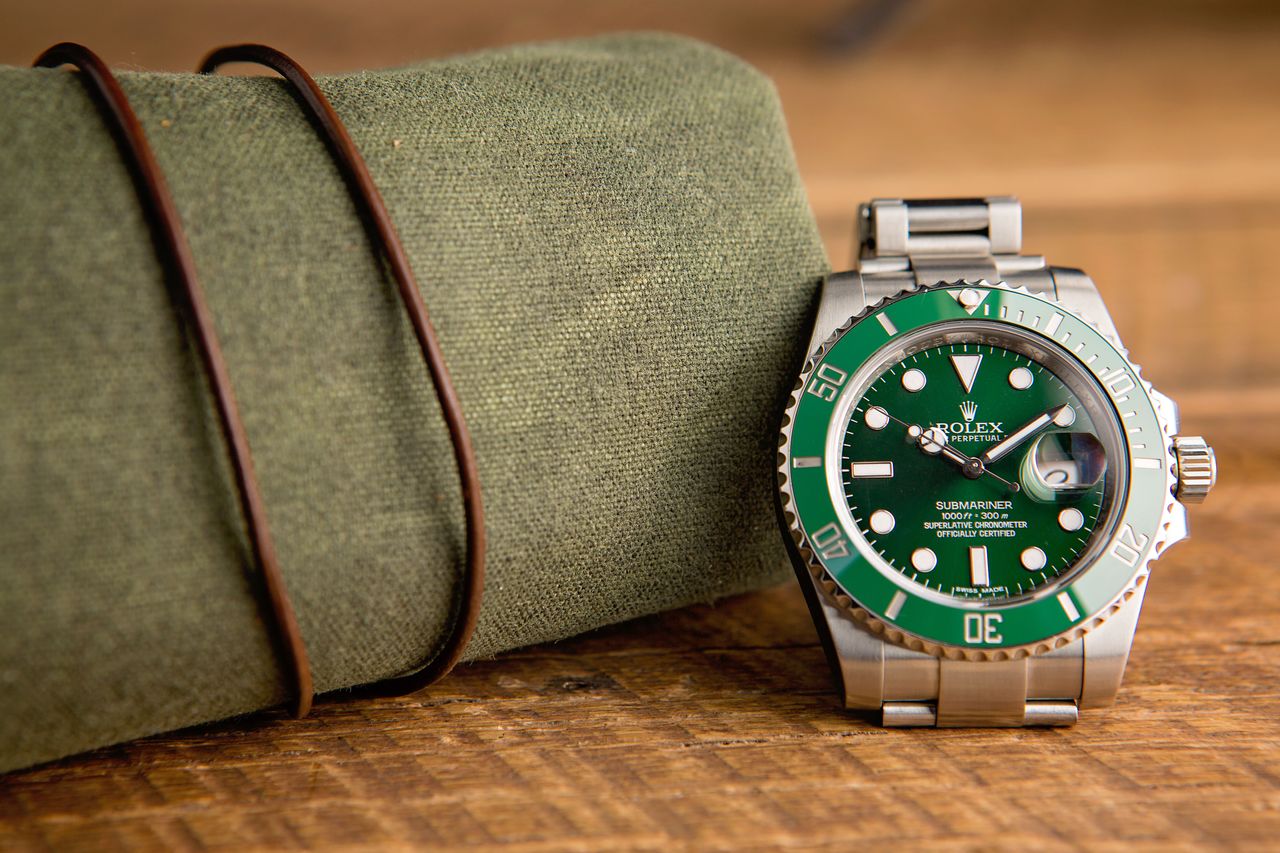Rolex Appreciation Beat Other Investments Over Past Decade
Why invest in the stock market when you can invest in your wrist.
With 10 years of sales data to draw from, the team at Bob’s Watches, an e-commerce retailer of pre-owned Rolexes and luxury watches, analysed how Rolex values have performed in the secondary market over the past decade compared to stocks, bonds, real estate, and gold. When the results came in, Rolex watches outperformed them all.
“We were surprised by how much the values have appreciated,” says Paul Altieri, founder and CEO of the California-based Bob’s Watches, during a recent interview, noting that few online sources have access to a full decade’s worth of sales data. “We were hoping to come up in the top three, so we were happy that it was number one.”
Evaluating percentage increases for gold and real estate, based on inflation-adjusted values for gold from macrotrends.net and median sales price data for houses sold in the U.S. from the Federal Reserve Economic Data (FRED) database, Rolex watches significantly outperformed both.
When it came to the Dow Jones Industrial Average, based on values from macrotrends.net, returns were comparable over the decade, but Rolex produced significantly higher appreciation percentages over the past five years.
According to the data, the average price of a used Rolex watch rose from less than US$5,000 in 2011 to more than US$13,000 by the end of last year. Intriguingly, the appreciation of Rolex watches since the beginning of the pandemic in early 2020 is nearly equal to the total price increase over the preceding five years.
“Demand is driving that, of course, inflation as well—but inflation only accounts for maybe 20%,” Altieri says. “The vast majority is overwhelming demand. Supply has been constrained and demand just keeps surging globally.”
He added that strong economic growth around the world, and particularly in China and elsewhere in Asia, over the past five years has also helped drive up values.
“Rolex has been a huge benefactor. I would say the same for Omega, Patek Philippe, and Breitling. A lot of brands have had tremendous success the last 10 years, especially the last five, and Rolex is certainly at the top of the list.”
Bob’s Watches also evaluated appreciation by Rolex model. Not surprisingly the brand’s purpose-built sport and tool watches account for eight of the top 15 reference numbers (including the top three positions). While the stainless-steel Submariner 16610 is the single best-selling Rolex reference over the past decade and its two-tone steel-and-gold sibling Ref. 16613 comes in second, Daytona is number one when it comes to the highest-appreciating model with an average pre-owned price topping US$30,000 last year.
“Daytona has always had a broader appeal, a stronger demand,” Altieri explained. “There is at least a five-year waitlist to purchase the new Daytona at retail. It’s a more complicated watch and it has always been a popular model with a higher value.”
As an example, he cites the Ref. 116500 Daytona with a white dial, which sells for around US$38,000 in the secondary market when the official retail price is about US$13,000. “That is the ultimate example of demand and supply being out of sync with each other,” he says.
To illustrate the dramatic shift that has taken place, he said that when Bob’s Watches entered the market in 2010, prices for pre-owned watches typically ran 25% to 40% below full retail in a store. Now, for some models, the pre-owned prices are dramatically higher than retail prices, because those new hot-ticket models are so hard to come by in a store.
Altieri points out that the imbalance has been growing over the last five to 10 years, and he doesn’t predict a correction any time soon. “I don’t see Rolex increasing production substantially to satisfy demand, so quantity will remain limited,” he says, adding that Omega is also surging in demand with unit sales almost doubling last year compared to 2020.
“Watches as a category are really popular today and growing,” he says. “Barring some major recession, I don’t think you will see any change. I know it seems unsustainable, like a bubble, but I just don’t see it changing.”
Reprinted by permission of Penta. Copyright 2021 Dow Jones & Company. Inc. All Rights Reserved Worldwide. Original date of publication: February 1, 2022.
 Copyright 2020, Dow Jones & Company, Inc. All Rights Reserved Worldwide. LEARN MORE
Copyright 2020, Dow Jones & Company, Inc. All Rights Reserved Worldwide. LEARN MORE
This stylish family home combines a classic palette and finishes with a flexible floorplan
Just 55 minutes from Sydney, make this your creative getaway located in the majestic Hawkesbury region.
The remote northern island wants more visitors: ‘It’s the rumbling before the herd is coming,’ one hotel manager says
As European hot spots become overcrowded , travellers are digging deeper to find those less-populated but still brag-worthy locations. Greenland, moving up the list, is bracing for its new popularity.
Aria Varasteh has been to 69 countries, including almost all of Europe. He now wants to visit more remote places and avoid spots swarmed by tourists—starting with Greenland.
“I want a taste of something different,” said the 34-year-old founder of a consulting firm serving clients in the Washington, D.C., area.
He originally planned to go to Nuuk, the island’s capital, this fall via out-of-the-way connections, given there wasn’t a nonstop flight from the U.S. But this month United Airlines announced a nonstop, four-hour flight from Newark Liberty International Airport in New Jersey to Nuuk. The route, beginning next summer, is a first for a U.S. airline, according to Greenland tourism officials.
It marks a significant milestone in the territory’s push for more international visitors. Airlines ran flights with a combined 55,000 seats to Greenland from April to August of this year, says Jens Lauridsen, chief executive officer of Greenland Airports. That figure will nearly double next year in the same period, he says, to about 105,000 seats.
The possible coming surge of travellers also presents a challenge for a vast island of 56,000 people as nearby destinations from Iceland to Spain grapple with the consequences of over tourism.
Greenlandic officials say they have watched closely and made deliberate efforts to slowly scale up their plans for visitors. An investment north of $700 million will yield three new airports, the first of which will open next month in Nuuk.
“It’s the rumbling before the herd is coming,” says Mads Mitchell, general manager of Hotel Nordbo, a 67-room property in Nuuk. The owner of his property is considering adding 50 more rooms to meet demand in the coming years.
Mitchell has recently met with travel agents from Brooklyn, N.Y., South Korea and China. He says he welcomes new tourists, but fears tourism will grow too quickly.
“Like in Barcelona, you get tired of tourists, because it’s too much and it pushes out the locals, that is my concern,” he says. “So it’s finding this balance of like showing the love for Greenland and showing the amazing possibilities, but not getting too much too fast.”
Greenland’s buildup
Greenland is an autonomous territory of Denmark more than three times the size of Texas. Tourists travel by boat or small aircraft when venturing to different regions—virtually no roads connect towns or settlements.
Greenland decided to invest in airport infrastructure in 2018 as part of an effort to expand tourism and its role in the economy, which is largely dependent on fishing and subsidies from Denmark. In the coming years, airports in Ilulissat and Qaqortoq, areas known for their scenic fjords, will open.
One narrow-body flight, like what United plans, will generate $200,000 in spending, including hotels, tours and other purchases, Lauridsen says. He calls it a “very significant economic impact.”
In 2023, foreign tourism brought a total of over $270 million to Greenland’s economy, according to Visit Greenland, the tourism and marketing arm owned by the government. Expedition cruises visit the territory, as well as adventure tours.
United will fly twice weekly to Nuuk on its 737 MAX 8, which will seat 166 passengers, starting in June .
“We look for new destinations, we look for hot destinations and destinations, most importantly, we can make money in,” Andrew Nocella , United’s chief commercial officer, said in the company’s earnings call earlier in October.
On the runway
Greenland has looked to nearby Iceland to learn from its experiences with tourism, says Air Greenland Group CEO Jacob Nitter Sørensen. Tiny Iceland still has about seven times the population of its western neighbour.
Nuuk’s new airport will become the new trans-Atlantic hub for Air Greenland, the national carrier. It flies to 14 airports and 46 heliports across the territory.
“Of course, there are discussions about avoiding mass tourism. But right now, I think there is a natural limit in terms of the receiving capacity,” Nitter says.
Air Greenland doesn’t fly nonstop from the U.S. because there isn’t currently enough space to accommodate all travellers in hotels, Nitter says. Air Greenland is building a new hotel in Ilulissat to increase capacity when the airport opens.
Nuuk has just over 550 hotel rooms, according to government documents. A tourism analysis published by Visit Greenland predicts there could be a shortage in rooms beginning in 2027. Most U.S. visitors will stay four to 10 nights, according to traveler sentiment data from Visit Greenland.
As travel picks up, visitors should expect more changes. Officials expect to pass new legislation that would further regulate tourism in time for the 2025 season. Rules on zoning would give local communities the power to limit tourism when needed, says Naaja H. Nathanielsen, minister for business, trade, raw materials, justice and gender equality.
Areas in a so-called red zone would ban tour operators. In northern Greenland, traditional hunting takes place at certain times of year and requires silence, which doesn’t work with cruise ships coming in, Nathanielsen says.
Part of the proposal would require tour operators to be locally based to ensure they pay taxes in Greenland and so that tourists receive local knowledge of the culture. Nathanielsen also plans to introduce a proposal to govern cruise tourism to ensure more travelers stay and eat locally, rather than just walk around for a few hours and grab a cup of coffee, she says.
Public sentiment has remained in favour of tourism as visitor arrivals have increased, Nathanielsen says.
—Roshan Fernandez contributed to this article.
This stylish family home combines a classic palette and finishes with a flexible floorplan
Just 55 minutes from Sydney, make this your creative getaway located in the majestic Hawkesbury region.






















